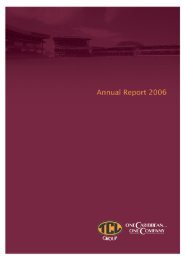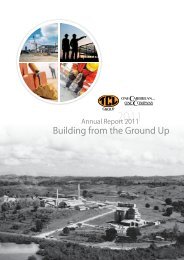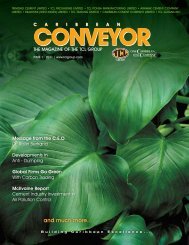Download File - TCL Group
Download File - TCL Group
Download File - TCL Group
Create successful ePaper yourself
Turn your PDF publications into a flip-book with our unique Google optimized e-Paper software.
NOTES TO THE CONSOLIDATED FINANCIAL STATEMENTS<br />
FOR THE YEAR ENDED 31ST DECEMBER, 2010<br />
(Expressed in Thousands of Trinidad and Tobago Dollars, except where otherwise stated)<br />
(Continued)<br />
22. Financial risk management<br />
Introduction<br />
The <strong>Group</strong>’s activities expose it to a variety of financial risks, including the effects of changes in debt and equity<br />
prices, interest rates, market liquidity conditions, and foreign currency exchange rates which are accentuated<br />
by the <strong>Group</strong>’s foreign operations, the earnings of which are denominated in foreign currencies. Accordingly,<br />
the <strong>Group</strong>’s financial performance and position are subject to changes in the financial markets. Overall risk<br />
management measures are focused on minimising the potential adverse effects on the financial performance of the<br />
<strong>Group</strong> of changes in financial markets.<br />
The Board of Directors is ultimately responsible for the overall risk management approach and for approving the<br />
risk strategies, principles and policies and procedures. Day to day adherence to risk principles is carried out by the<br />
executive management in compliance with the policies approved by the Board of Directors.<br />
Credit risk<br />
Credit risk is the risk that a counter-party will not meet its obligations under a financial instrument or customer<br />
contract, leading to a financial loss. The <strong>Group</strong> is exposed to credit risks from its operating activities (primarily for<br />
trade receivables) and from its financing activities, including deposits with banks and financial institutions, foreign<br />
exchange transactions and other financial instruments.<br />
Significant changes in the economy, or in the state of a particular industry segment that represents a concentration<br />
in the <strong>Group</strong>’s portfolio, could result in losses that are different from those provided at the reporting date.<br />
Management therefore carefully manages its exposure to credit risk.<br />
The <strong>Group</strong> structures the level of credit risk it undertakes by placing limits on the amount of risk accepted in<br />
relation to one customer, or group of customers, and to geographical and industry segments. Such risks are<br />
monitored on an ongoing basis, and limits on the levels of credit risk that the <strong>Group</strong> can engage in are approved<br />
by the Board of Directors.<br />
Exposure to credit risk is further managed through regular analysis of the ability of debtors and borrowers to settle<br />
outstanding balances, meet capital and interest repayment obligations and by changing these lending limits when<br />
appropriate. The <strong>Group</strong> does not hold collateral as security.<br />
The following table shows the maximum exposure to credit risk for the components of the statement of financial<br />
position, without taking account of any other credit enhancements:<br />
Gross<br />
Gross<br />
maximum maximum<br />
exposure exposure<br />
2010 2009<br />
Receivables and prepayments 66,889 75,400<br />
Cash and cash equivalents 643 4,313<br />
Total credit risk exposure 67,532 79,713<br />
Credit risk related to receivables<br />
Customer credit risk is managed in accordance with the <strong>Group</strong>’s established policy, procedures and control relating<br />
to customer credit risk management. Credit limits are established for all customers based on internal rating criteria.<br />
Outstanding customer receivables are regularly monitored. At 31 December 2010 the <strong>Group</strong> had approximately<br />
6 individual customers (2009: 14 customers) that owed the <strong>Group</strong> more than $1.0 million each and accounted for<br />
approximately 63% (2009: 67%) of all trade receivables owing.<br />
38<br />
BUILD TO LAST FOR GENERATIONS













